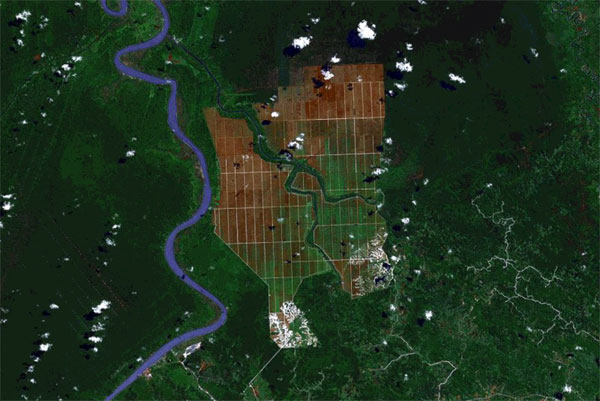Rainforest destruction increasingly driven by corporate interests, not poverty
Rainforest destruction increasingly driven by enterprises, not poverty
An interview with Dr. Thomas K. Rudel, forest researcher at Rutgers
Rhett A. Butler, mongabay.com
December 18, 2007
|
|
Tropical deforestation is increasingly enterprise-driven rather than the result of subsistence agriculture, a trend that has critical implications for the future of the world’s forests, says Dr. Thomas Rudel, a researcher from Rutgers University. As urbanization and government-sponsored development programs dwindle in the tropics, industrial logging and conversion for large-scale agriculture — including oil palm plantations, soy farms, and cattle ranches — are ever more important causes of forest destruction.
Globally the U.N. estimates some 13 million hectares of forest are cleared each year, a figure only slightly changed from recent decades. But these numbers mask an insidious transition from government- and subsistence-driven deforestation to corporate-driven forest destruction.
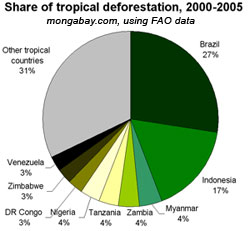
|
From the 1960s through the 1980s, a large proportion of deforestation was the result of government policies promoting rural development, including agricultural loans and road construction. These initiatives, particularly in Brazil and Indonesia — the countries with the most extensive tropical forest cover — drove large-scale deforestation by small landholders. Today, economic stability, a reduction in guerilla movements, an increasing global financial market, and a worldwide commodity boom are conspiring to create a ripe environment for development by the private sector, says Rudel. While centrally planned development projects and poverty alleviation programs were once the engines of road construction and colonization schemes, today political impetus for large infrastructure projects comes from industry interests seeking to facilitate access to international markets. Surging demand for grain, driven by insatiable thirst for biofuels and rising standards of living in developing countries (more meat consumption requires more grain as feed), are fueling the trend.
A reason for hope?
Rudel says that while the corporatization of deforestation is cause for concern, it could also be reason for optimism.
 Dr. Tom Rudel |
“The growing importance of decision-making by the heads of farms and agribusinesses in driving deforestation also implies that, to be effective, new directions in conservation policy should focus on influencing the decisions that the heads of enterprises make,” Rudel wrote in a 2007 Land Use Policy paper.
Already the formation of groups like Alianca da Terra for beef producers in Brazil and the Roundtable on Sustainable Palm Oil suggest that industry is sensitive to pressure on environmental concerns, perhaps more so than government agencies or masses of rural poor. Seizing on the vulnerability of their public image, activist groups increasingly target the heads of multinational corporations in their campaigns. Last year, after pressure from Greenpeace, a group of the largest soy crushers in the Amazon agreed to a moratorium on soy until they can devise a tracking mechanism to ensure their crop is coming from responsible producers. Similar supply chain management systems may soon be seen for Amazon beef and palm oil from southeast Asia. Several financial firms, including Goldman Sachs, JP Morgan Chase, Citigroup Inc. and Bank of America Corp, have made concessions on their lending and funding practices relating to forest destruction following campaigns from environmentalists.
In a December 2007 interview with mongabay.com, Rudel talked about the changing face of deforestation as well as his personal experiences in one of the most biodiverse ecoregions of the planet: the eastern slope of the Andes in Ecuador and Peru. Since first visiting the areas as a Peace Corps volunteer in Ecuador in the late 1960s, Rudel has witnessed the dramatic transformation of forests for agriculture.
AN INTERVIEW WITH DR. THOMAS RUDEL
Mongabay: In your 2005 book “Tropical Forests: Regional Paths of Destruction and Regeneration in the Late 20th Century” and subsequent “Land Use Policy” paper, you report a striking shift in the drivers of tropical deforestation since the 1970s. Why has deforestation become more enterprise-driven since then? Have changes in government policy in forest lands had a significant impact? What about globalization? Have forces driving deforestation varied by region?
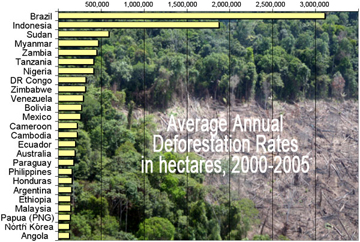
|
Rudel: Deforestation has become more ‘enterprise driven’ during the past two decades because in many ways national governments have withdrawn from rural areas. In the 1960s and 1970s national governments launched programs of integrated rural development that featured the construction of new roads, settlements along the roads, and the provision of services like schools and credit for small farmers. During the 1980s the debt crisis, a decline in rural guerilla movements, and an increase in urban populations convinced many politicians that federal governments should get to out of the rural development business. Governments still build roads, as in Brazil, but these projects usually have a powerful interest group (e.g. soybean farmers in Brazil) lobbying for the new roads.
Globalization has made a big difference because as governments were scaling down their efforts, timber firms, sometimes based in Southeast Asia, were ramping up their efforts. The recent interest of Asian logging firms in logging the Amazon basin and the recent sale of large amounts of Central African wood to China exemplify these trends.
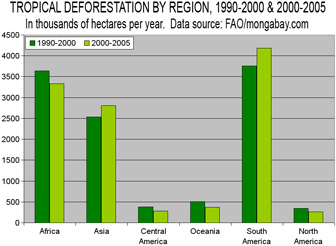
|
With the continuing destruction of old growth tropical forests, new regional patterns have emerged. Deforestation has declined in West Africa, Central America, and South Asia because they have few old growth forests left. With this pattern the locus of old growth deforestation has narrowed to the three remaining large blocks of forest in South America, Central Africa, and Southeast Asia. In this sense deforestation occurs in fewer places, but it represents just as much of a threat to the remaining biodiversity as it did twenty years ago.
Historically government forest policies have not had much of an effect on patterns of deforestation, but there may be changes afoot here. The growth in government promoted reforestation efforts, especially in Asia, is striking. It may be too much to hope for, but it is conceivable that these programs might relieve some of the economic pressure to cut down the old growth forests.
Mongabay: In your 2007 “Land Use Policy” paper, you note that logging eventually led to the establishment of cattle pasture in Brazil and oil palm plantations in Indonesia and Malaysia. Does commercial logging continue to play a significant role in driving conversion of forest lands for agriculture and other uses?
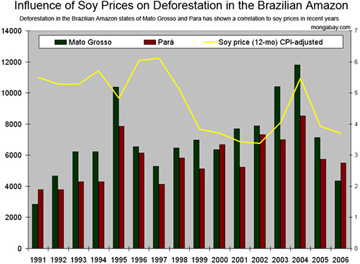
|
Rudel: Yes. It happens in severally different ways. After the end of subsidies for cattle ranching operations in the Amazon during the late 1980s, landowners would log their lands first and use the proceeds from the logging to finance the purchase of cattle for the pastures on the new farms. Fire also plays a role here. The logging leaves behind so much ‘slash’ (dead wood, branches, stumps etc.) that the likelihood of destructive fires on these lands grows. These fires destroy seed sources and make less likely that the lands would reforest if left alone. Under these circumstances landowners never consider reestablishing forests on these cutover lands. In the outer islands of Indonesia a somewhat similar dynamic unfolds. Corporations reap profits from the sale of the wood from old growth forests and then devote the land to another profitable land use, oil palm plantation.
Mongabay: Some researchers (for example Wright and Muller-Landau 2007) have suggested that slowing rural population growth coupled with urbanization will give forests a reprieve and allow them to recover. Do you agree with this assessment or will factors like market-driven industrial agriculture and plantations continue to put pressure on forest lands? What’s your near and long-term out look for tropical forests?
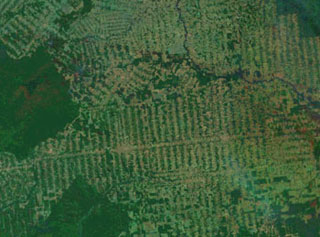
|
Rudel: I don’t see the demand for wood slowing down at all, but more of it may come from forest plantations that, for the most part, will not be established on places that currently contain old growth forests. In this context where wood continues to command a high price, there will continue to be ‘cut and run’ logging in places with tropical forests and weak states (E.g. PNG, Congo, Solomon Islands) that have difficulty regulating loggers. Cutting in the Amazon basin will continue I am sure, but one of the big questions concerns whether or not Brazil will establish a system of national forests to try and regulate the exploitation of the region’s forests. If they do establish these forests (and climate change negotiations may matter here), then the outlook for Amazon forests brightens a lot. In other regions I expect that we will see more scrub growth with a significant presence of invasive species in places that had biodiverse, old growth tropical forests in 1950.
Mongabay: In a 2000 paper you noted that conservation groups have had a tough time protecting forest in the Amazon. How can conservation groups be more effective?
Rudel: Oil companies (for example) have a lot of discretion about how they exploit a site. For example, serving wells by monorail rather than by a road has large consequences for deforestation in and around oil fields. Three and four party negotiations about these issues, including NGOs, can accomplish some meaningful gains. I would hope that the NGOs would not be afraid to talk to the companies for fear of being branded a ‘sell out’. At the same time the NGOs need to be able to exact a high environmental price (in the form of preserved lands or reduced cutting around pipelines) for the legitimacy that they are conferring on the companies.
Mongabay: What is the best way to manage forests to ensure they will be around for future generations? Do you see a place for carbon finance/avoided deforestation in forest conservation?
Rudel: Definitely! It is a very hopeful sign that a coalition of forest rich countries is already raising this issue in the preliminary discussions about extending or re-authorizing the Kyoto Protocol.
Mongabay: What can people do here in the United States to help ensure the sustainable management/protection of forests?
Rudel: Don’t buy mahogany furniture or eat Brazilian beef (it used to be banned from the US, but it no longer is). Mahogany invariably comes from old growth forests, and these 200 year old trees are just extracted; no replanting occurs. Teak is a different matter.
Mongabay: It seems that your work in the Peace Corps had a significant influence on your focus of research. What about that experience led you to pursue this path?
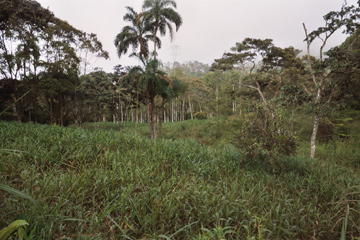 Shaded cattle pasture in the Ecuadorian Amazon. Photo by Tom Rudel |
Rudel: The Peace Corps experience did make a big difference in my life. It was a much more intense and meaningful experience than all of my years in various schools. Growing up,I had always cared about the environment and wondered how to reconcile economic growth with environmental conservation, but the Peace Corps experience raised that concern to a fevered pitch. For several years back in the late 1960s and early 1970s I helped landless peasants improve themselves by mowing down the rain forest where the Andes meets the Amazon in Ecuador. I could see the loss of biodiversity and the economic gains of poor people going on right in front of my eyes. In some senses I guess that, by researching and writing about deforestation, I have trying to atone for my environmental sins ever since. In other way the whole experience just underscored for me how difficult it is to do sustainable development the right way. It ends up being an intellectual puzzle, yes, but it is also an issue with real moral content for me. I am still in touch with the people that I worked with so long ago, and that adds meaning to this work as well.
Mongabay: Do you have any advice for students wanting to pursue a career in forest research?
Rudel: I think that it is important to alternate periods of practice, outside of schools, with study in schools. The work outside of schools gives meaning to the abstractions that one studies and grounds much of what goes on in schools. So going to a school of forestry or environmental studies makes a lot of sense, but it was a much richer experience for me when I did it because I had spent some time in the field before I went back to school.
Mongabay: What’s your favorite place to visit in the tropics?
Rudel: I would have to say that the eastern slope of the Andes where it meets the Amazon in Ecuador and Peru would be my favorite place. When the weather clears (a big ‘if’), the views back into the Andes are ‘out of this world’. You can be looking up at snow covered volcanoes while standing in a place festooned with tropical plants. Whew! The view downstream from Macchu Pichu captures the same kind of scene from a different angle.
